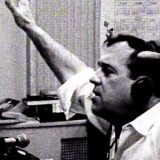The Nine Most Important Words In Podcasting
Someone once challenged me to explain the secret of good communication in 10 words or less. I only needed nine.
The person who talks to everybody talks to nobody.
In the interests of full disclosure, I did not come up with that sentence. I didn’t even come up with the idea. I first read about it in a long, lost interview with Dan Ingram. That’s a name you may not be familiar with if (a) you are under 50, (b) you grew up outside of the New York metropolitan area or (c) both. Ingram is arguably the best radio disc jockey of the Top 40 era. He was quick witted and devastatingly funny. He was also one of the best communicators I ever heard. His secret?
The person who talks to everybody talks to nobody.
Ingram held down the afternoon drive slot for WABC in New York, at the time the most listened to radio station in the nation. Every word that came out of his mouth was heard by about 10 million people. You’d never know it. When you listened to Ingram on the air it was eerily clear that he was talking to you, and only you. He often said that he cringed every time he heard a disc jockey begin a show with, “Hello, everybody.” From that moment on, Ingram knew the jock might as well have been talking to the studio wall.
(Here’s a clip of Ingram telling a story about a station staffer who lost a wheel cover while driving into work on the Long Island Expressway. Hear how he sounds as if he’s telling the story to you, and then let’s you listen in as he describes the wheel cover’s fate to the staffer.)
What This Means for Podcasters
As you might suspect, the same rules apply whether your voice is coming out of a car radio or a podcast app. That’s not my idea, either. Holland Cooke, one of the country’s premiere radio consultants made a similar point at NMX in Las Vegas this past April.
“If you’re doing a show for everybody, you’re doing a show for nobody.”
Okay, you’re convinced. You’re going to start talking to just one person. Uh…just what person is that? Here are some tips to get you started.
Four Tips to Keep You From Talking to Your Studio Wall
- Visualize your ideal listener. It doesn’t make any difference who that listener is, as long as he or she falls into your target audience. Details are important here. Rather than “She’s a woman in her 30s,” think “She’s an attractive woman, 35, fun-loving, a little flirty, who’s on the verge of landing her dream job.” Married? Single? Divorced? The more details you can provide, the more real this listener will be to you.
- Visualize what your ideal listener is doing while she’s listening to your podcast. She might be doing the laundry (whites or colors?), commuting (in an Explorer or a Prius?), exercising at the gym (treadmill or free weights?) or binging on comfort food (ice cream or mac and cheese?).
- Talk to your ideal listener as if you were there beside her. In real life, you wouldn’t be hyper-excited if she were unwinding at the end of the day. Nor would you be all soothing and calming if she were pushing to sprint that last quarter mile. Not only would you match your delivery to her situation and emotions, you’d do it naturally. And that leads us to tip number four…
- Talk, don’t think. Now you can see why it’s important to visualize your ideal listener in detail. In a one-on-one conversation, you’d use visual and auditory clues to direct your own words and body language. Since you can’t see your listeners, you have to depend upon the image of your ideal listener to guide you. The more real that image is to you, the less likely you are to overthink what (and how) you want to say. You’ll simply be you—which is exactly what makes a good communicator.
Whether the medium is radio or podcasting the philosophy is the same: talk to everyone and you’ll talk to no one; talk to one person and you’ll talk to to them all.









